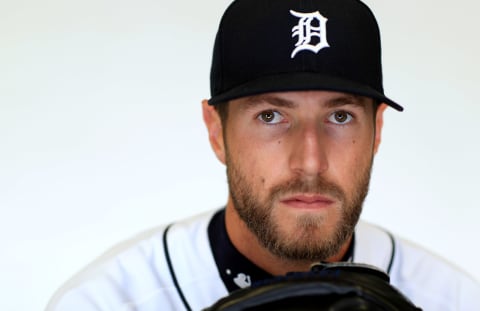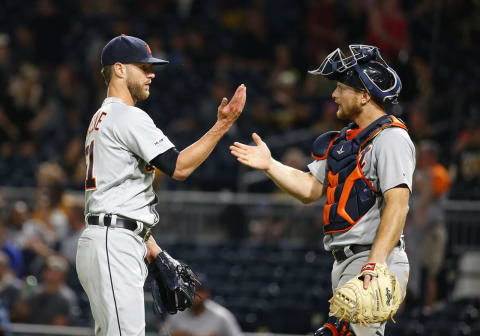Atlanta Braves: Grass wasn’t Greener in 2019, how will Shane Greene fare in 2020?


The Atlanta Braves made a splash at last year’s trading deadline to reel in Tigers closer Shane Greene. However, Greene didn’t continue his dominance he had over in the AL for a last place team. What can we expect in 2020?
Shane Greene had humble beginnings before the Atlanta Braves. He toiled through the Yankees minor league system slowly and methodically, finally making the majors in 2014 during his age 25 season. Initially, he was a starting pitcher, and performed well as a rookie in the Bronx. He pitched to a solid 3.78 ERA and won six games over 14 starts.
That solid performance was enough to get some mileage out of Greene in a trade package. That offseason, Greene was sent to Detroit as a part of a three team deal. In that deal, the Tigers sent prospects Robbie Ray and Domingo Leyba to Arizona, and Arizona sent shortstop Didi Gregorius to the Yankees.
The trade turned out okay for everyone, and the net for each team was a solid (or better than solid in Ray and Gregorius) major league player each.
In 2015, the Tigers kept Greene as a starter, and things went terribly, as opponents launched 13 home runs off him and he pitched to a 6.88 ERA over 83.2 innings. His FIP was 5.14.
Since we’ll be talking a lot about FIP in this article, let’s define it. FIP stands for Fielding Independent Pitching, meaning: how good is this pitcher at getting strikeouts and preventing walks, hit batters and avoiding giving up home runs.
Some argue that FIP is a more true measure of how good a pitcher really is.
In simpler terms, it takes out any ‘bad luck’ caused by fielding. When comparing Greene’s 2015 ERA of 6.88 ERA and his FIP of 5.12, you could say that Greene’s numbers were inflated by a bit of bad luck. Remember how this works for later.
Greene’s best season pre-2019 was his 2017 season where he eventually earned the Tigers’ closer role after being moved to the bullpen, notching nine saves. He pitched to a 2.66 ERA that year.
In 2018, he picked up 32 saves, but did so with a 5.12 ERA. So impressive, but highly stressful. We all know Atlanta Braves fans hate a stressful reliever.
To sum it up, before the 2019 season, Greene was worth 0.1 WAR – meaning he was just a tick above replacement level… he was a very average pitcher.

the All-Star
2019 was a bit of a different season for Shane Greene. For one, he stopped being average and started being great. Over the first half of the season for the Tigers, he was flat out dominant. He racked up 22 saves for a team that finished 2019 with just 47 wins. His ERA was just 1.18, his WHIP was a microscopic 0.86, but his FIP came in at 3.69.
As for his FIP, this suggests that Greene was definitely good – but got pretty lucky in terms of his fielding helping him out. Remember, FIP measures how good a pitcher is at getting strikeouts, and preventing things like walks, hit batters and home runs.
No one is trying to take away from Greene’s All-Star first half, but let’s a look at his ERA/FIP splits for his career.
- 2014: 3.78 ERA /3.73 FIP
- 2015: 6.88 ERA/5.14 FIP
- 2016: 5.82 ERA/3.13 FIP
- 2017: 2.66 ERA/3.84 FIP
- 2018: 5.12 ERA/4.61 FIP
- 2019: 1.18 ERA/3.69 FIP (with Tigers)
- 2019: 4.01 ERA/3.94 FIP
Looking at these numbers and throwing out 2015 and 2018, his two worst seasons, that his FIP sits somewhere in the mid to upper 3’s. He was having a lucky, but average year during the first half of 2019.
Greene, the Atlanta Braves pitcher
So with that point made, when the Atlanta Braves acquired Greene for Joey Wentz and Travis Demeritte at the trading deadline, did they expect him to keep up that 1.18 ERA? Probably not, but they sure hoped so.
Atlanta Braves fans expected him to come in and blow away people. Like say, John Rocker at his peak or Craig Kimbrel.
Greene didn’t. It wasn’t as drastic as Cinderella pre- and post-midnight, but he simply just returned to his averages.
His first two outings, even his four of his first six outings were particularly concerning. He didn’t post a clean inning, lost a game, and blew two saves. That stretch from August 3 to August 13 was one to forget for Greene.
However, the rest of the season that spanned 21 appearances, he only gave up earned runs three times- one twice, and two once.
None of those three appearances resulted in a loss or a blown save for the Atlanta Braves. Over those 20.1 innings, he allowed just four runs. That’s a 1.77 ERA. Lucky or not, that re-aligned him with what Atlanta Braves fans expected… he just wasn’t doing it in the closer’s role. That job was Mark Melancon‘s.
Worth mentioning, Greene did blow a save in game 4 of the NLDS. He struck out the side but allowed a run to score that tied the game at four.

Will the grass be Greener?
As good as Greene’s 2019 season was, it’s difficult to tell what exactly may happen. The promising part is, after a ten day implosion, he did return back to more first-half like numbers (1.18 ERA with Detroit, 1.77 ERA in his last 20 appearances with Atlanta).
Throwing out his bad stretch right after the Atlanta Braves acquired him, Greene was as advertised. He just wasn’t the closer. However, did anyone really see Alex Anthropoulos making a second splash and getting Mark Melancon from the Giants, too? That’s why it’s so true that you can never really have too many pitchers.
What will Greene’s role be?
Shane Greene loses his arbitration case, awarded $6.25 million from the Atlanta #Braves instead of his request for $6.75 million.
— Bob Nightengale (@BNightengale) February 5, 2020
With the acquisition of Will Smith to start the offseason, along with the presence of Mark Melancon, I think it’s safe to say that Greene won’t be the closer for the Atlanta Braves this year. That job will likely fall to Smith, with Melancon getting the first shot should that be needed.
While Greene won’t be ‘the man,’ this does mean that manager Brian Snitker will have four pitchers with closing experience, counting Luke Jackson. That’s an enviable place to be as a major league manager. Just think of all of the combinations that Snit will have at his disposal to throw at teams.
I just really hope this doesn’t turn into a closer-by-committee situation- I’ve always felt that the closer was a one man job. It’s not even that the Atlanta Braves couldn’t have success with this approach – it’s just if I was a manager, I would want defined roles.
As the seventh inning guy (or round about that time) I think that Greene could flourish in a role that doesn’t have the pressure of a closer for a team that’s contending for a World Series.
Both Smith and Melancon have experience with that. So if I’m looking to Greene and thinking of what his numbers can be, I’m going to bank on the guess that he’ll be good in 2020.
Next. Does Touki Toussaint have a role in 2020?. dark
Prediction for Greene’s 2020: 3-2, 2.75 ERA, 65 IP, 67 K, 28 BB, 2 SV. He’ll anchor the middle innings when needed, and serve as a set-up man at times, too. He’ll pick up a couple of saves because the major league season is long, and arms need rest.